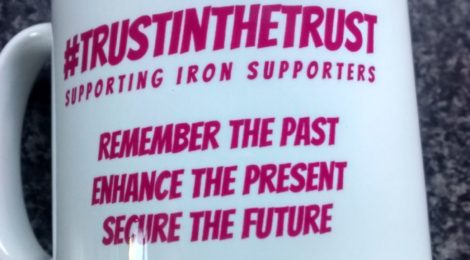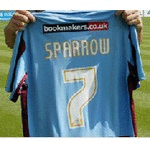
Memories of Trust Member Barry Wilkinson, 75 years an Iron!
A few brief sentences are in the Darlington Trust newsletter but these don’t do justice to Barry’s memories so we’ve posted a fuller version here on the website. I’m sure he could write a book about his experiences but Barry has kept it to less than 700 words.
From Barry’s pen;
“I was 10 years old in May 1950, at the time Scunthorpe were newly elected to the Football League’s Third Division North. My dad took me to the very first home game at the Old Showground against Shrewsbury. I remember standing on the terrace and the crowd making way for me to get to the front fence for a better view. The game ended in a 0-0 draw, and my dad said I had asked him why they didn’t play until somebody scored! I remember Jack Brownsword playing in that team, but it was in a later season when Jack Hubbard was signed as the other fullback. Whenever JB took a penalty (usually scoring), JH would turn his back, unable to bear watching.
I think I was about 17 or 18 years old when we won promotion to the Second Division, attracting crowds of around 13-15 thousand at the OSG. We had a very good team, with Barrie Thomas, our record goalscorer, among others. Barrie was later transferred to Newcastle, much to the displeasure of many supporters, and we consequently missed out on promotion to the First Division. I firmly believe we would have made it had we not started selling our best players. Not only did we lose supporters, but we also lost our way after 5 or 6 seasons due, as I later learned, to a lack of finances, which led to relegation back to the Third Division.
Despite that, it was a fantastic time being a supporter of the Iron against teams now in the Premiership. I remember standing on the terrace in line with the halfway line at Liverpool, and by full-time, I was somewhere near the corner flag. There was good spirit among the Anfield crowd, who commented on our own good players. No segregation in those days. I think Dick White, our centre-half, was the first of many to transfer to Liverpool.
I remember the formations teams played in those days, with two fullbacks, three halfbacks, and five forwards. Nowadays, it’s completely the opposite. But would the likes of our old inside forwards—Ronnie Waldock, Brian Godfrey, Bobby Smith, to name a few—fit into today’s setup? In another team of ours, Jack Haigh would give a player a good rollicking if the ball wasn’t played to his feet when passing—another thing missing in today’s play going forward, and a shortcoming of a midfield general.
By the early sixties, I had moved to London and supported the Iron whenever they were in the area. It’s where my late wife worked at the FA Headquarters in Lancaster Gate as secretary/PA to the Director of Coaching, Alan Wade. One day, when I called in to see her, the World Cup was on her desk. I couldn’t resist holding it in the air, but I had been spotted and had to quickly put it back and disappear.
When I returned to Scunthorpe in later years, the Iron were in Division Four, and it was perhaps the most miserable time for me as a supporter, with crowds at their lowest ever. Then, with finance dictating, we moved to the new ground. Eventually, we had the Wembley play-offs and championship football; we were on a roll with another very good team who wanted security and new contracts moving forward—but those were not offered. As a result, the team broke up. Coupled with other major problems over time, we are now where we are.
The club is extremely fortunate to have superb owners and directors who saved us from extinction some 18 months ago. We are now in a continued rebuilding period of sustainability, a chunk of which depends on maintaining the level of support through the gate, which is pleasing considering what division we’re in. But I appreciate it is a difficult balancing act, and it depends a lot on the players’ performance. With 100% support, optimism, and hard work, we will return to the better days most of us remember.”


